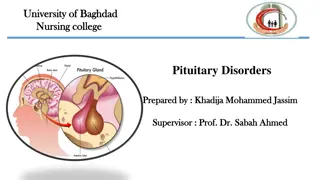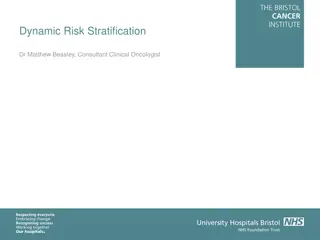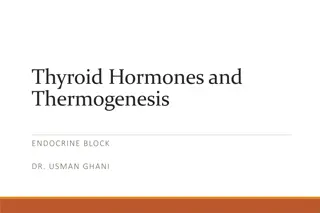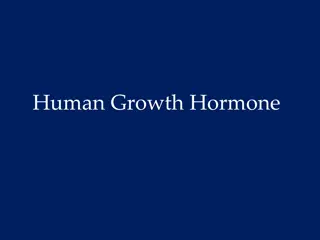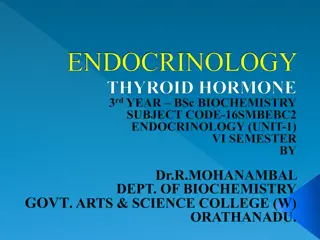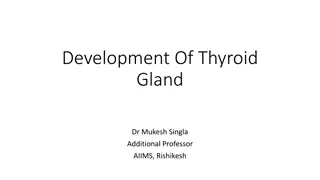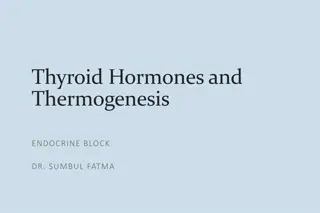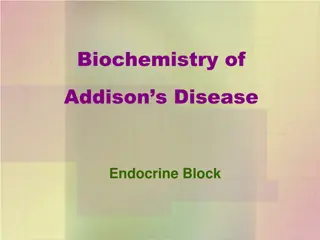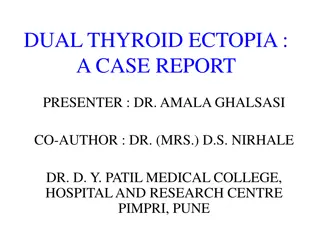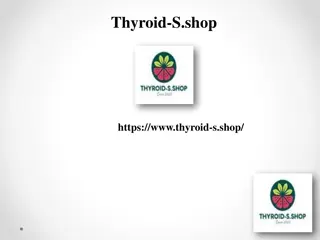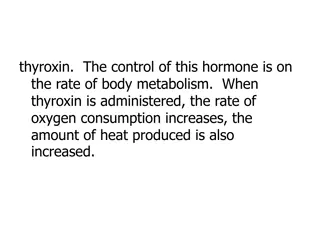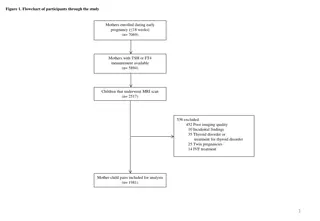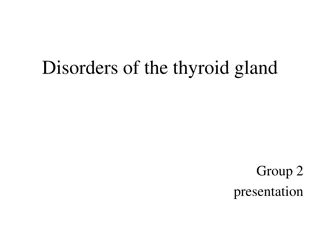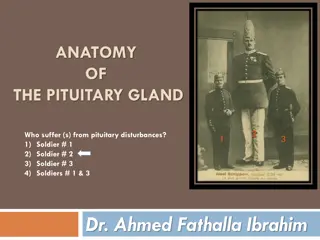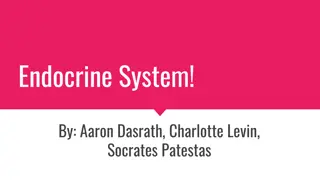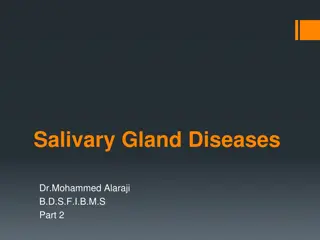Understanding the Thyroid Gland: Functions and Hormone Synthesis
The thyroid gland is a vital endocrine gland located below the larynx, responsible for producing thyroid hormones essential for regulating metabolism. This gland consists of follicles lined with follicular cells, producing thyroglobulin and thyroid hormones T3 and T4. Iodine plays a crucial role in the synthesis of these hormones, with a detailed process involving iodide trapping, transport, oxidation, and coupling reactions. Understanding the microscopic features and synthesis of thyroid hormones can provide insights into its significance in maintaining overall health.
Download Presentation

Please find below an Image/Link to download the presentation.
The content on the website is provided AS IS for your information and personal use only. It may not be sold, licensed, or shared on other websites without obtaining consent from the author. Download presentation by click this link. If you encounter any issues during the download, it is possible that the publisher has removed the file from their server.
E N D
Presentation Transcript
THYROID GLAND By Dr. Saurabh Yadav Assistant Prof. Department of Kriya Sharir HAMC&H
INTRODUCTION Thyroid is a one of the largest gland of the endocrine gland. Location - Below the larynx on each side of trachea and anterior to the trachea. It has two lobes, which are connected in the middle by an isthmus. Weight 10-20 gm in adults.
MICROSCOPIC FEATURES Thyroid gland contain about 3 million follicles. These follicles are lined with cuboidal epithelial cells called follicular cells. Follicular cavity is filled with a colloidal substance known as thyroglobulin (TG), which is secreted by follicular cells. TG is a protein and thyroid hormones are obtains from TG. In between the follicular cells, parafollicular cells are present, which secrete calcitonin.
SYNTHESIS OF THYROID HORMONE About 93 % of hormones secreted by the thyroid gland is thyroxine (T4), and 7 % triiodothyronine (T3). Iodine is very essential for the formation of thyroid hormones. Iodine is consumed through diet. iodine is converted into iodide and absorbed from GI tract. For the synthesis of normal quantities of thyroid hormones, approximately 1 mg of iodine is required per week or about 50 mg per year.
Thyroglobulin Synthesis Endoplasmic reticulum and Golgi apparatus in the follicular cells of thyroid gland synthesize and secrete continuously. Thyroglobulin molecule glycoprotein containing 140 molecules of amino acid tyrosine. thyroglobulin is a large
Synthesis of thyroid hormone occurs in five stages Iodide trapping Transport of iodide into follicular cavity Oxidation of iodide Iodination of tyrosine ( organification) Coupling reaction
Iodide trapping Iodide is actively transported from blood into follicular cell, against electrochemical gradient. This process is called iodide trapping. Iodide is transported into the follicular cell along with sodium by sodium-iodide symport pump, which is also called iodide pump. Transport of iodide into follicular cavity From the follicular cells, iodide is transported into the follicular cavity by an iodide- chloride pump called pendrin.
Oxidation of iodide Inside the follicular cavity, iodide is oxidized to iodine by the help of an enzyme called thyroperoxidase and its accompanying hydrogen peroxide. Iodide must be oxidized to iodine, because only iodine is capable of combining with tyrosine to form thyroid hormones. Absence or inactivity of this enzyme stops the synthesis of thyroid hormones.
Iodination of tyrosine ( organification) The binding of iodine with the thyroglobulin molecule is called organification of the thyroglobulin. Then, iodine (I) combines with tyrosine, which is thyroglobulin. Iodination accelerated by the enzyme iodinase, which is secreted by follicular cells. already present process in is Iodination of tyrosine occurs in several stages. Tyrosine is monoiodotyrosine (MIT) and later into di- iodotyrosine (DIT). MIT and DIT are called the iodotyrosine residues. iodized first into
Coupling reaction One molecule of DIT and one molecule of MIT combine to form triiodothyronine (T3). Two molecules of DIT combine to form tetrai- odothyronine (T4) or thyroxine.
STORAGE OF THYROID HORMONES After synthesis, the thyroid hormones remain in the form of vesicles within thyroglobulin and are stored for long period. Each thyroglobulin molecule contains up to 30 thyroxine molecules triiodothyronine molecules. In this form, the thyroid hormones are stored in the follicles for 2 to 3 months. So, when the synthesis of thyroid hormone stops, the signs and symptoms of deficiency do not appear for about 2 to 3 months. and a few
RELEASE OF THYROID HORMONES FROM THE THYROID GLAND Thyroglobuline itself is not released into the circulating blood. the hormones are first cleaved from the thyroglobulin and then these free hormones are released. 1. Follicular cell sends foot-like extensions called pseudopods, which thyroglobulin hormone complex. This process is mediated by a receptor-like substance called megalin, which is present in the membrane of follicular cell. 2. Pseudopods convert thyroglobulin hormone complex into small pinocytic vesicles and enter into follicular cell. close around the
3. Then, lysosomes of the cell fuse with these vesicles. 4. Digestive enzymes such as proteinases present in lysosomes digest (proteolysis) the thyroglobulin molecules and release the hormones. 5. Now, the hormones diffuse through base of the follicular cell and enter the capillaries. Blood and various organs in our body notably liver, kidney, heart and skeletal muscle convert the T4 into T3 by an enzyme called monodeiodinase. Most of the T3 found in blood is the T3 derived from T4 by these organs. A small amount of T4 is converted into reverse T3.
6. Remain MIT & DIT are iodinated tyrosines & free from the thyroglobulin molecules. 7. They are not secreted into the blood, Instead, their iodine is cleaved from them by a de-iodinase enzyme & again this iodine is recycled to form additional thyroid hormones.
TRANSPORT OF THYROID HORMONES IN THE BLOOD Thyroid hormones are transported in the blood by three types of proteins: 1. Thyroxine-binding globulin (TBG) 2. Thyroxine-binding prealbumin (TBPA) 3. Albumin. 1. Thyroxine-binding Globulin (TBG) Thyroxine-binding globulin is a glycoprotein and its concentration in the blood is 1 to 1.5 mg/dL. It has a great affinity for thyroxine and about one third of the hormone combines strongly with this protein.
2. Thyroxine-binding Prealbumin (TBPA) TBPA transports one fourth of the thyroid hormones. It is also called transthyretin (TTR). 3. Albumin Albumin transports about one tenth of the thyroid hormones.
POTENCY AND DURATION OF ACTION The potency of T3 is four times more than that of T4. T4 acts for longer period than T3. Duration of T4 action is four times more than T3 action. This is because of the difference in the affinity of these hormones to plasma proteins. T3 has less affinity for plasma proteins and combines loosely with them, so that it is released quickly. T4 has more affinity and strongly binds with plasma proteins, so that it is released slowly. Therefore, T3 acts on the target cells immediately and T4 acts slowly.
CELLULAR ACTION OF THYROID HORMONE Thyroid hormone enter cells through membrane transporter protein. Within the cell, most of the T4 is deiodinated to form T3. Now, thyroid hormones enter the nucleus of cell and bind with thyroid hormone receptors (TR), which are either attached to DNA genetic strands or in close proximity to them. TR is always bound to another receptor called retinoid X receptor (RXR). The receptors become activated and initiate the transcription process. Then large numbers of different types of messenger RNA are formed, which activate the ribosomes to synthesize the new proteins.
REGULATION OF THYROID HORMONE SECRETION Secretion of thyroid hormones is controlled by anterior pituitary and hypothalamus through feedback mechanism. ROLE OF HYPOTHALAMUS Hypothalamus regulates thyroid secretion by controlling TSH secretion through thyrotropic- releasing hormone (TRH). Median eminence of hypothalamus secrets TRH and TRH is transported through the hypothalamo-hypophyseal portal vessels to the anterior pituitary. After reaching the pituitary gland, the TRH causes the release of TSH.
ROLE OF PITUITARY GLAND Thyroid-stimulating hormone (TSH) secreted by anterior pituitary is the major factor regulating the synthesis and release of thyroid hormones. 1. Increased the number of follicular cells of thyroid. 2. Increased the conversion of cuboidal cells into columnar cells in thyroid gland and thereby it causes the development of thyroid follicles. 3. Increased size and secretory activity of follicular cells. 4. Increased activity of the iodide pump and iodide trapping in follicular cells.
5. Increased thyroglobulin secretion into follicles. 6. Increased Iodination of tyrosine and coupling to form the hormones. 7. Increased proteolysis of the thyroglobulin, by which release of hormone is enhanced and colloidal substance is decreased. FEEDBACK CONTROL - Increased thyroid hormone in the body fluids decreases secretion of TRH from hypothalamus and pituitary. TSH from anterior
FUNCTIONS OF THE THYROID HORMONES ACTION ON BASAL METABOLIC RATE (BMR) Thyroid hormone increases the metabolic activities in most of the body tissues, except brain, retina, spleen, testes and lungs. It increases BMR by increasing the oxygen consumption of the tissues. The action that increases the BMR is called calorigenic action. Hyperthyroidism, BMR increases - 60% to 100% above the normal level. Hypothyroidism, BMR falls - 20% to 40% below the normal level.
ACTION ON PROTEIN METABOLISM Thyroid hormone increases the synthesis of proteins in the cells. ACTION ON CARBOHYDRATE METABOLISM Thyroid hormone stimulates almost all aspects of carbohydrate metabolism. glucose absorption from GI tract. glucose uptake by the cells, by accelerating the transport of glucose through the cell membrane. breakdown of glycogen into glucose. gluconeogenesis. Hyperthyroidism blood glucose Hypothyroidism blood glucose
ACTION ON FAT METABOLISM Thyroid hormone decreases the fat storage by mobilizing it from adipose tissues and fat depots. The mobilized fat is converted into free fatty acid and transported by blood. free fatty acid level in blood. ACTION ON PLASMA AND LIVER FATS Increase thyroid hormone decreases the concentrations of cholesterol, phospholipids, and triglycerides in the plasma, even though it increases the free fatty acids. Hypothyroidism - cholesterol level in plasma increases, resulting in atherosclerosis. Thyroid hormone increases deposition of fats in the liver, leading to fatty liver. Thyroid hormone decreases plasma cholesterol level by increasing its excretion from liver cells into bile.
ACTION ON VITAMIN METABOLISM Thyroid hormone increases the formation of many enzymes and vitamins form essential parts of the enzymes. Hyperthyroidism vitamin deficiency ACTION ON GROWTH Thyroid hormone accelerates the growth of the body, especially in growing children. Lack of thyroid hormone arrests the growth. In hyper secretion of thyroid hormone, excessive skeletal growth often occurs, causing the child to become taller at an earlier age. Thyroid hormone causes early closure of epiphysis. So, the height of the individual may be slightly less in hypothyroidism. Thyroid hormone is more important to promote growth and development of brain during fetal life and first few years of postnatal life. Deficiency of thyroid hormones during this period leads to mental retardation and the brain remains smaller than normal.
ACTION ON BODY WEIGHT Increase thyroid hormone secretion decreases the body weight and fat storage. Decrease thyroid hormone secretion increases the body weight because of fat deposition. ACTION ON BLOOD Thyroid hormone increases erythropoietin production and increases blood volume. Polycythemia is common in hyperthyroidism.
ACTION ON CARDIOVASCULAR SYSTEM Thyroid hormone acts directly on heart and increases the heart rate. It is an important clinical investigation for diagnosis of hypothyroidism and hyperthyroidism. Due to its effect on enzymatic activity, thyroid hormone increases the force of contraction of the heart. In hyperthyroidism or in thyrotoxicosis, the heart may become weak due to excess activity and protein catabolism. So, the patient may die of cardiac decompensation. Thyroid hormone causes vasodilatation by increasing the metabolic activities. Thyroid hormone increase in rate and force of contraction of the heart, increase in blood volume and blood flow, increase in cardiac output. This in turn, increases the blood pressure. But, generally, the mean pressure is not altered. Systolic pressure increases and the diastolic pressure decreases.
ACTION ON RESPIRATION The increased rate of metabolism increases the utilization of oxygen and formation of carbon dioxide. These two factors stimulate the respiratory centers to increase the rate and depth of respiration. ACTION ON GASTROINTESTINAL TRACT Thyroid hormone increases the appetite and food intake. It also increases the secretion of digestive juices and movements of GI tract. So, hypersecretion of thyroid hormone causes diarrhea and the lack of thyroid hormone causes constipation.
ACTION ON CENTRAL NERVOUS SYSTEM Thyroid hormone promote growth and development of the brain during fetal life and during the first few years of postnatal life. Thyroid deficiency in infants results in abnormal development of synapses, defective myelination and mental retardation. during the hypersecretion of thyroid hormone, there is excess stimulation of the CNS. So, the person is likely to have extreme nervousness and may develop psychoneurotic problems such as anxiety complexes, excess worries or paranoid thoughts. Hyposecretion of thyroxine leads to lethargy and somnolence (excess sleep). ACTION ON SKELETAL MUSCLE when the quantity of hormone becomes excessive, the muscles become weakened because of excess protein catabolism. lack of thyroid hormone causes the muscles to become sluggish, and they relax slowly after a contraction.
ACTION ON SLEEP Hypersecretion of thyroid hormone causes excessive stimulation of the muscles and central nervous system. So, the person feels tired, exhausted and feels like sleeping. But, the person cannot sleep because of the stimulatory effect of thyroid hormone on synapses. hyposecretion of thyroxine causes somnolence. ACTION ON SEXUAL FUNCTION In men, hypothyroidism leads to complete loss of libido and hyperthyroidism leads to impotence. In women, hypothyroidism causes menorrhagia and polymenorrhea. In some women, it causes irregular menstruation and occasionally Hyperthyroidism in women leads to oligomenorrhea and sometimes amenorrhea. amenorrhea.
APPLIED PHYSIOLOGY GOITER enlargement of the thyroid gland. It occurs both in hypothyroidism and hyperthyroidism. Goiter in Hyperthyroidism Toxic Goiter Toxic goiter is the enlargement of thyroid gland with increased secretion of thyroid hormones. Goiter in Hypothyroidism Non-toxic Goiter Non-toxic goiter is the enlargement of thyroid gland without increase in hormone secretion. the non-toxic hypothyroid goiter is classified into two types. 1. Endemic colloid goiter 2. Idiopathic non-toxic goiter.
Endemic colloid goiter Endemic colloid goiter is the non-toxic goiter caused by iodine deficiency. Because of lack of iodine, there is no formation of hormones. By feedback mechanism, hypothalamus and anterior pituitary are stimulated. It increases the secretion of TRH and TSH. The TSH then causes the thyroid cells to secrete tremendous thyroglobulin into the follicle. As there are no hormones to be cleaved, the thyroglobulin remains as it is and gets accumulated in the follicles of the gland. This increases the size of gland. amounts of
Idiopathic non-toxic goiter Idiopathic non-toxic goiter is the goiter due to unknown cause. Enlargement of thyroid gland occurs even without iodine deficiency. It may be due to thyroiditis and deficiency of enzymes such as peroxidase, iodinase and deiodinase, which are required for thyroid hormone synthesis. HYPERTHYROIDISM Increased secretion of thyroid hormones is called hyperthyroidism. Hyperthyroidism is caused by: 1. Graves disease 2. Thyroid adenoma
Graves disease Graves disease is an autoimmune disease and it is the most common cause of hyperthyroidism. In Graves disease, the B lymphocytes (plasma cells) produce autoimmune antibodies autoantibodies (TSAbs). These antibodies act like TSH by binding with membrane receptors of TSH. This results in hypersecretion of thyroid concentration of thyroid hormones caused by the antibodies suppresses the TSH production also. So, the concentration of TSH is low. called thyroid-stimulating hormones. The high Thyroid adenoma Sometimes, a localized tumor develops in the thyroid tissue. It is known as thyroid adenoma and it secretes large quantities of thyroid hormones. As far as this adenoma remains active, the other parts of thyroid gland cannot secrete the hormone. This is because, the hormone secreted from adenoma depresses the production of TSH.
Symptoms of Hyperthyroidism Intolerance to heat Increased sweating Mild to extreme weight loss Varying degrees of diarrhea Muscle weakness Nervousness or other psychic disorders Extreme fatigue but inability to sleep
HYPOTHYROIDISM Decreased secretion of thyroid hormones is called hypothyroidism. Hypothyroidism leads to myxedema in adults and cretinism in children. Myxedema Where hypothyroidism is present for a long time, mucopolysaccharides, chondroitin sulfate, infiltrate into the various tissues, causing non-pitting edema or myxedema. symptoms of myxedema 1. Swelling of the face 2. Bagginess under the eyes 3. on-pitting edema 4. Atherosclerosis hyaluronic acid and
Cretinism Cretinism is the hypothyroidism in children, characterized by stunted growth. Cretinism occurs due to congenital absence of thyroid gland, genetic disorder or lack of iodine in the diet. Features of cretinism Sluggish movements Croaking sound while crying Tongue large and protruding Broad and flat nose Umbilical hernia


